How To Tie A Decorative Knot In Rope For Curtains
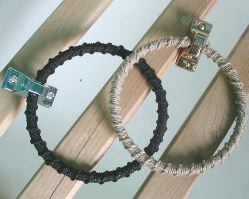
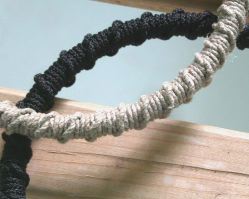
Knots for Interiors
These knotted hoop towel holders feature the decorative ropework technique known as a grapevine service, and were made as a special social club. At sea, a service on a rope or ring would protect against chafing.
A 3mm string was worked around a solid ring with a netting needle, creating a spiral upshot.
The two rope worked hoop towel rail measured approximately 14cm each in diameter. One used a natural fibre hemp cord equally a decorative hitching, the other was finished in black polypropylene 3mm cord.
We have a selection of rope towel runway for sale equally role of our Knotted products department: for details please run across the Rope Towel Holders folio
Decorative Knotted Loop Endings
This pattern features as an ending for a drapery tie-back fabricated from large diameter rope. based on a traditional type with loops or rings at the ends to ready onto existing tieback hooks set up in the wall.
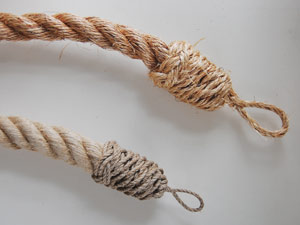
The decorative loop ending could be used in whatsoever situation where a large bore rope needs to exist finished with a thinner 1.
Making a secure join between two very different thicknesses of rope (ie. the main body of the tieback to the loop) presents quite a challenge. All the solutions involve some elaborate knotwork and a lot of patience.
This prototype shows two decorative rope loop endings on drape tiebacks; the higher one fabricated with a 18mm diameter manila rope and the lower one from 24mm diameter hemp. A continiuous crown plaiting in 6mm manila cord and 3mm flax respectively, forms an stop cap for the rope. Each is finished with a turks head whipping at the base.
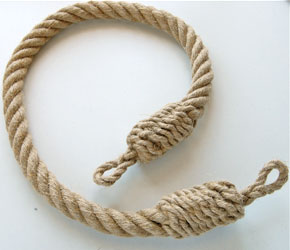
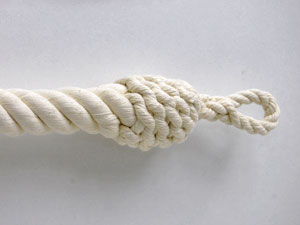
The cotton fiber 24mm necktie-back above shows the terminate cap made using the strands following out from the eyesplice at the pinnacle in 8mm bore rope.
The larger bore rope is offset whipped. The strands of the unlaid 8mm rope are tucked and sewn through the lay of the 24mm rope on the other side of the whipping, to secure the cap to the principal torso. These strands are then crown plaited back up around the thicker rope towards the loop, and finished with a double crown knot at he base of the eye-splice.
A complete particular is shown in 24mm hemp.
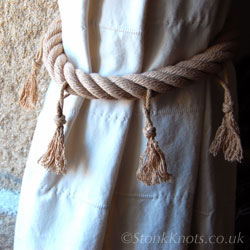
Shown hither is a version of the loop-ended 24mm rope mantle tie-back in situ: this one was made from a pale natural-coloured p.o.south.h. (very high quality spun polyester) with a few decorative tassels added along the way.
Another ending for a rope tie-back is a brass or chromed barrier rope fitting which tin can be attached to the ends of a short rope and used in the same way. On the barrier rope page you can run into a traditional method we employ to secure these hook ended caps to the rope.
We offering various designs of rope tie-backs to order in our rope products section.
Star Knot Tassel Tie-backs
These natural fibre rope curtain necktie-backs feature a sailor's push button knot known as the star knot, with a tassel terminate. They were made using 6mm cotton and hemp cords and finished with a decorative whipping in flax twine.
To make one tie-back, six strands of mixed natural fibre cords were used; three each of 6mm cotton fiber and hemp. The star knot is worked past seizing the six divide strands together and making round turns in 1 after some other, each 1 being led around the previously worked strand.
These Star knots were topped with a Double Crown knot with all the strands neatly tucked out of sight. Each tassel end was spirally whipped with flax cord using a technique known every bit the grapevine service. The remaining tassel was then thoroughly combed out using a dog-comb, and finally all the uneven strands neatly trimmed with scissors.
A smaller version of the star knot tassel using 4mm cords is available to order as a decorative lightpull on our rope products section.
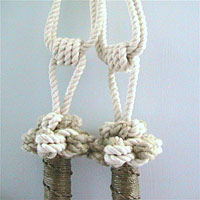
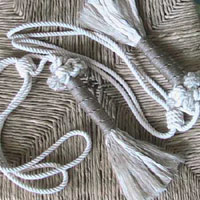
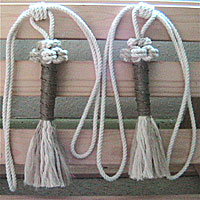
How To Tie A Decorative Knot In Rope For Curtains,
Source: https://stairropes.com/knotsforthehome.html
Posted by: chapmanancterionts.blogspot.com


0 Response to "How To Tie A Decorative Knot In Rope For Curtains"
Post a Comment